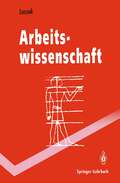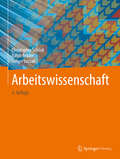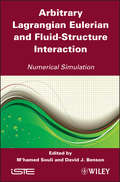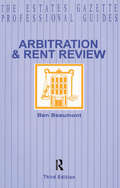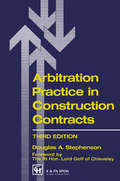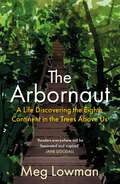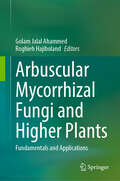- Table View
- List View
Arbeitsvorbereitung II: Der Mensch, Leistung und Lohn, technische und betriebswirtschaftliche Organisation (Fertigung und Betrieb #6)
by F. Pristl W. FrankeArbeitsweise der selbsttätigen Drehbänke: Kritik und Versuche
by Herbert KienzleDieser Buchtitel ist Teil des Digitalisierungsprojekts Springer Book Archives mit Publikationen, die seit den Anfängen des Verlags von 1842 erschienen sind. Der Verlag stellt mit diesem Archiv Quellen für die historische wie auch die disziplingeschichtliche Forschung zur Verfügung, die jeweils im historischen Kontext betrachtet werden müssen. Dieser Titel erschien in der Zeit vor 1945 und wird daher in seiner zeittypischen politisch-ideologischen Ausrichtung vom Verlag nicht beworben.
Arbeitswissenschaft (Springer-Lehrbuch)
by Holger LuczakDie Arbeitswissenschaft ist jung und anspruchsvolle Publikationen sehr rar. Insbesondere fehlt eine systematische Übersicht, die als Lehrbuch den Veranstaltungen zugrunde liegen kann. Das vorliegende Buch unterscheidet sich durch einen systematischen Zugang von den vorliegenden Werken. Es behandelt Arbeitsbegriffe und arbeitsanalytische Konzepte. In der disziplinären Übersicht kommen der Konstitution, der Qualifikation und Leistungsdisposition der Arbeitskräfte besondere Bedeutung zu. Dabei wird dem Wandel von manuellen zu mentalen Arbeitsformen Rechnung getragen und somit der rein physiologische Aspekt relativiert. Zur Gestaltung und Beurteilung der Arbeitsumgebung und Arbeitsgestaltung werden physikalische und physiologische Grundlagen und praxisnahe Erkenntnisse unter den Aspekten Arbeitsschutz, Technologie, Organisation und Ergonomie sowie unter Abwägung ökonomischer Aspekte vermittelt. Damit steht erstmalig eine übersichtliche Darstellung der Problemfelder der Arbeitswissenschaft zur Verfügung, die für Studenten und für Arbeitsplaner in der Praxis gleichermaßen nützlich ist.
Arbeitswissenschaft
by Holger LuczakDas Buch bietet einen systematischen Zugang zur Arbeitswissenschaft. Konstitution, Qualifikation und Leistungsdisposition der Arbeitskräfte werden behandelt, der Wandel von manuellen zu mentalen Arbeitsformen und der rein physiologische Aspekt relativiert. Zur Gestaltung und Beurteilung der Arbeitsumgebung und Arbeitsgestaltung werden physikalische und physiologische Grundlagen und praxisnahe Erkenntnisse unter den Aspekten Arbeitsschutz, Technologie, Organisation und Ergonomie sowie unter Abwägung ökonomischer Aspekte vermittelt. Damit steht diese übersichtliche Darstellung der Problemfelder der Arbeitswissenschaft wieder zur Verfügung. Die zweite Auflage wurde vollständig neubearbeitet und erweitert.
Arbeitswissenschaft (Springer-Lehrbuch)
by Holger Luczak Ralph Bruder Christopher SchlickKomplexität und Dynamik prägen die heutige Arbeitswelt und erzeugen hohe Anforderungen an die Leistungs-, Innovations- und Wandlungsfähigkeit der Unternehmen und ihrer Beschäftigten. Die Gestaltung effizienter und produktiver Arbeitsprozesse, in denen Mitarbeiterinnen und Mitarbeiter schädigungslose, erträgliche und zumutbare Arbeitsbedingungen vorfinden, Handlungsspielräume entfalten, ihre Kompetenzen einbringen und in Kooperation mit anderen weiterentwickeln können, gewinnt deshalb zunehmend an Bedeutung. Das Buch erläutert als arbeitswissenschaftliches Lehrbuch und Nachschlagewerk die wesentlichen Modelle und Methoden zur Analyse, Gestaltung und Optimierung von Arbeitsprozessen im Hinblick auf die genannten Kriterien. Hierbei werden zentrale Gegenstandsbereiche arbeitswissenschaftlicher Forschung und Lehre wie Arbeitspersonen, Arbeitsformen, Betriebs- und Arbeitsorganisation, Gruppen- und Teamarbeit, Arbeitszeit, Arbeitswirtschaft, Arbeitsschutz, betriebliche Gesundheitsförderung, Arbeitsumgebung sowie Ergonomie fachsystematisch dargestellt und anhand von Gestaltungsbeispielen praxisnah vermittelt. Die vierte Auflage wurde vollständig überarbeitet.
Arbeitswissenschaft
by Christopher M. Schlick Ralph Bruder Holger LuczakDie Gestaltung effizienter und produktiver Arbeitsprozesse, in denen Mitarbeiter Kreativität und Persönlichkeit entfalten können, ist für die Wettbewerbsfähigkeit von Unternehmen besonders wichtig. Das arbeitswissenschaftliche Standardwerk erläutert die wesentlichen Modelle und Methoden zur Analyse, Gestaltung und Optimierung von Arbeitsprozessen. Kernthemen wie Arbeitsorganisation, Arbeitswirtschaft, Ergonomie, Arbeitstechnologie, Arbeitsschutz und Arbeitsökologie werden systematisch dargestellt und anhand von Gestaltungsbeispielen vermittelt.
Arbitrary Lagrangian Eulerian and Fluid-Structure Interaction: Numerical Simulation
by David J. Benson Mhamed SouliThis book provides the fundamental basics for solving fluid structure interaction problems, and describes different algorithms and numerical methods used to solve problems where fluid and structure can be weakly or strongly coupled. These approaches are illustrated with examples arising from industrial or academic applications. Each of these approaches has its own performance and limitations. Given the book’s comprehensive coverage, engineers, graduate students and researchers involved in the simulation of practical fluid structure interaction problems will find this book extremely useful.
Arbitrary Lagrangian Eulerian and Fluid-Structure Interaction: Numerical Simulation (Iste Ser.)
by M'Hamed Souli David J. BensonThis book provides the fundamental basics for solving fluid structure interaction problems, and describes different algorithms and numerical methods used to solve problems where fluid and structure can be weakly or strongly coupled. These approaches are illustrated with examples arising from industrial or academic applications. Each of these approaches has its own performance and limitations. Given the book’s comprehensive coverage, engineers, graduate students and researchers involved in the simulation of practical fluid structure interaction problems will find this book extremely useful.
Arbitrary Modeling of TSVs for 3D Integrated Circuits (Analog Circuits and Signal Processing)
by Khaled Salah Yehea Ismail Alaa El-RoubyThis book presents a wide-band and technology independent, SPICE-compatible RLC model for through-silicon vias (TSVs) in 3D integrated circuits. This model accounts for a variety of effects, including skin effect, depletion capacitance and nearby contact effects. Readers will benefit from in-depth coverage of concepts and technology such as 3D integration, Macro modeling, dimensional analysis and compact modeling, as well as closed form equations for the through silicon via parasitics. Concepts covered are demonstrated by using TSVs in applications such as a spiral inductor and inductive-based communication system and bandpass filtering.
The Arbitration Act 1996: A Commentary
by Bruce Harris Rowan Planterose Jonathan Tecks"There should not be a practitioner who does not have a copy ... highly recommended."—Arbitration When first published, The Arbitration Act 1996: A Commentary was described by Lord Bingham as "intensely practical and admirably user-friendly". It remains the most readable, useful, practical and user-friendly guide to the Arbitration Act 1996. The courts – particularly the Commercial and the Technology & Construction Courts – continue to grapple with many questions relating to the Act, with many judgments reported since the previous edition was published. While many of these do not add to the wisdom on this legislation, for the fifth edition the authors have considered some 330 new cases, resulting in extensive changes throughout much of the commentary. Many of the cases going to court concern challenges to awards and as a result the commentary on the relevant sections of the Act (ss. 67, 68, 70 and 72) has been subject to very substantial revision indeed. The details of all of these changes are of great importance to practitioners, whether lawyers or arbitrators. In addition there have been some significant changes to the Model Law since publication of the previous edition, which are fully documented and commented upon. Alterations to the CPR, the new UNCITRAL Rules (2010), the new ICC Rules (2012) and the new ICE Arbitration Procedure (2010) are also covered. Written by three practising arbitrators, the fifth edition continues to be the essential handbook for all concerned with English arbitration.
The Arbitration Act 1996: A Commentary
by Bruce Harris Rowan Planterose Jonathan Tecks"There should not be a practitioner who does not have a copy ... highly recommended."—Arbitration When first published, The Arbitration Act 1996: A Commentary was described by Lord Bingham as "intensely practical and admirably user-friendly". It remains the most readable, useful, practical and user-friendly guide to the Arbitration Act 1996. The courts – particularly the Commercial and the Technology & Construction Courts – continue to grapple with many questions relating to the Act, with many judgments reported since the previous edition was published. While many of these do not add to the wisdom on this legislation, for the fifth edition the authors have considered some 330 new cases, resulting in extensive changes throughout much of the commentary. Many of the cases going to court concern challenges to awards and as a result the commentary on the relevant sections of the Act (ss. 67, 68, 70 and 72) has been subject to very substantial revision indeed. The details of all of these changes are of great importance to practitioners, whether lawyers or arbitrators. In addition there have been some significant changes to the Model Law since publication of the previous edition, which are fully documented and commented upon. Alterations to the CPR, the new UNCITRAL Rules (2010), the new ICC Rules (2012) and the new ICE Arbitration Procedure (2010) are also covered. Written by three practising arbitrators, the fifth edition continues to be the essential handbook for all concerned with English arbitration.
Arbitration and Rent Review
by Ben BeaumontArbitration and Rent Review has become a standard work in the property world for guidance on rent review. In a clear style, the author examines the procedures that landlord and tenant should follow in order to agree a new rent or to have one decided by arbitration. By means of cases, he highlights the key areas of conflict that come before the courts, the contentious issues being introduced in the order in which they would be encountered by landlords or tenancts facing a review.
Arbitration and Rent Review
by Ben BeaumontArbitration and Rent Review has become a standard work in the property world for guidance on rent review. In a clear style, the author examines the procedures that landlord and tenant should follow in order to agree a new rent or to have one decided by arbitration. By means of cases, he highlights the key areas of conflict that come before the courts, the contentious issues being introduced in the order in which they would be encountered by landlords or tenancts facing a review.
Arbitration Awards: A Practical Approach
by Ray Turner‘Drawing on his long and practical experience [the author gives] guidance which only the foolhardy would reject without good reason for doing so. With this manual beside him, many an arbitrator will, I feel sure, sleep the sounder.’ - The Rt Hon The Lord Bingham of Cornhill. The preparation of an arbitrator's award requires a rigorous approach to the consideration of submissions and evidence, and to the decisions stemming from that consideration, and the arbitrator must be competent to draft a valid and enforceable award. These tasks can be complex for any arbitrator, particularly so for the less experienced. This book has been written to provide clear and practical guidance, whilst emphasising that there is no standard method of preparing or writing an award. It includes illustrations relating to a wide range of types of award. It will be of interest to all arbitrators and those involved in the process, whether they are concerned with commodities, insurance, maritime matters, rent disputes, construction or commerce.
Arbitration Practice in Construction Contracts
by D.A. StephensonConsiders each stage in the course of an arbitration in detail, from the claimant's decision to seek the means of resolving a dispute to the arbitrator's award, explaining clearly and concisely what is expected of the claimant, respondent and arbitrator and when.
Arbitration Practice in Construction Contracts
by D.A. StephensonConsiders each stage in the course of an arbitration in detail, from the claimant's decision to seek the means of resolving a dispute to the arbitrator's award, explaining clearly and concisely what is expected of the claimant, respondent and arbitrator and when.
Arbitration Practice in Construction Contracts
by Douglas S. StephensonSince it came into force on 31 January 1997 the Arbitration Act 1996 has generally been welcomed by users and practitioners in the construction industry. It has fulfilled expectations that it would provide a user-friendly and practical basis of resolving disputes arising from construction contracts in a fair, expeditious and economical way. In doing so it has generated a modest volume of case law that has demonstrated the excellence of the Act's provisions and its drafting. Since the Fourth Edition of this book appeared in 1997 the Housing Grants, Construction and Regeneration Act 1996 with its Scheme for Construction Contracts Regulations 1998 have come into force, as have the Civil Procedure Rules 1998, both of which affect the resolution of disputes arising from construction contracts. Case law has arisen from the Construction Act, and from the House of Lords' judgment in the Beaufort Developments case, overturning the much-criticised judgment of the Court of Appeal in Crouch. In this Fifth Edition of an established text the author deals with each stage of an arbitration, explaining in practical terms the procedures to be adopted in avoiding disputes and in dealing with them efficiently when they do arise. It features over 20 specimen arbitration documents and includes the full text of the Act. It also covers several important developments in case law affecting construction arbitrations, and refers to the introduction and case law arising from adjudication under the Housing Grants, Construction and Regeneration Act 1996.
The Arbornaut: A Life Discovering the Eighth Continent in the Trees Above Us
by Meg LowmanOne of the world's first tree-top scientists, Meg Lowman is both a pioneer in her field - she invented one of the first treetop walkways - and a tireless advocate for the planet. In a voice as infectious in its enthusiasm as in its practical optimism, The Arbornaut chronicles her irresistible story. From climbing solo hundreds of feet into Australia's rainforests to measuring tree growth in the northeastern United States, from searching the redwoods of the Pacific coast for new life to studying leaf-eaters in Scotland's Highlands, from a bioblitz in Malaysia to conservation planning in India to collaborating with priests in Ethiopia's last forests, Lowman launches us into the life and work of a scientist and ecologist. She also offers hope, specific plans and recommendations for action; despite devastation across the world, we can still make an immediate and lasting impact against climate change.
Arbuscular Mycorrhizal Fungi and Higher Plants: Fundamentals and Applications
by Golam Jalal Ahammed Roghieh HajibolandThis book covers the fundamentals of arbuscular mycorrhizal fungi (AMF) and higher plant symbiosis with potential implications in crop production. It provides new insights into our understanding of the mechanisms of AMF-mediated plant growth regulation and stress tolerance covering the most recent biochemical, physiological, molecular, environmental, and ecological studies. Focusing on AMF-induced physiological and molecular mechanisms of enhanced tolerance to stress, environmental stress is discussed in several dedicated chapters. The book provides not only updated information with new insights and perspectives but also several new topics, such as a comprehensive discussion on biotic stressors, AMF interaction with other microorganisms, non-host plant species, plant secondary metabolism, signaling events in plant-AMF symbiosis, AMF-mediated nutrient acquisition and subsequent stress tolerance. The book also discusses the potential implications of AMF for sustainable crop production inthe context of climate change. The book can be a useful reference book for academics and scientists involved in related research, such as academics in agronomy and plant sciences, scientists involved in beneficial fungi research, chemists, industrialists, and employees involved in the production and marketing of biofertilizers, master and doctoral degree students of agronomy, horticulture, and plant protection, consultants working on the production of crops in marginal environments as well as environmental scientists working for assisted phytoremediation programs. It would also be suitable for agronomy, ecology, and plant science-related courses, such as plant stress physiology, plant growth-promoting microbes, and plant pathology to teach undergraduate, graduate, and postgraduate students at colleges and universities.
Arbuscular Mycorrhizal Fungi in Sustainable Agriculture: Inoculum Production and Application
by Amitava Rakshit Manoj Parihar Alok Adholeya Yinglong ChenThis 2-volume book is an up-to-date overview of current progress in Arbuscular Mycorrhizal Fungal (AMF) technique development, inoculum production and its quality regulations, application in agriculture, horticulture, agroforestry, and other ecosystems, along with nutrient management for sustainable food production. It contains the current advancement in basic and molecular techniques, challenges, opportunities, and determinates of various AMF production methods and major tools and techniques for their field application. Production and development of AMF is rapidly evolving and requires a multidisciplinary approach with up-to-date knowledge to broaden and strengthen the perspective of researchers involved in this domain. The volumes offer new insight and cutting-edge information for novices and experts such as students, academicians, researchers, environmentalists, industrialists, and others interested in mycorrhiza. The first volume covers some basic isolation techniques, enumeration,and molecular studies with recent advances in various in-vitro and in-vivo production technologies, regulatory issues, and application methodologies for field inoculation. It also discusses AMF application in various agroecosystems for sustainable agricultural production and a healthier planet.
Arbuscular Mycorrhizal Fungi in Sustainable Agriculture: Nutrient and Crop Management
by Amitava Rakshit Manoj Parihar Alok Adholeya Yinglong ChenThis 2 volume book is an up-to-date overview of current progress in Arbuscular Mycorrhizal Fungal (AMF) technique development, inoculum production and its quality regulations, application in agriculture, horticulture, agroforestry and other ecosystems along with nutrient management for sustainable food production. It offers new insight and cutting-edge information for novices and experts such as students, academicians, researchers, environmentalists, industrialists, and other individuals interested in the field of mycorrhiza.AMF provides favorable rhizospheric environment to the plant with numerous direct and indirect mechanisms, in exchange of soil nutrients and photosynthetically fixed carbon. Other than the species composition and diversity determination of natural ecosystem, AMF play a vital role in maintaining the soil quality, agricultural sustainability and environmental integrity. The second volume provide comprehensive knowledge on AMF role in nutrient cycling, nutrient exchange and their acquisition under normal and stress condition.
ARC Flash Hazard Analysis and Mitigation (IEEE Press Series on Power Engineering #91)
by J. C. DasUp-to-date analysis methodologies and practical mitigation for a major electrical safety concern Arc Flash Hazard Analysis and Mitigation is the first book to focus specifically on arc flash hazards and provide the latest methodologies for its analysis as well as practical mitigation techniques. Consisting of sixteen chapters, this fully up-to-date handbook covers all aspects of arc flash hazard calculations and mitigation. It addresses the calculations of short circuits, protective relaying, and varied electrical systems configurations in electrical power systems. It also examines protection systems, including differential relays, arc flash sensing relays, protective relaying coordination, current transformer operation and saturation, and applications to major electrical equipment from the arc flash point of view. Current technologies and strategies for arc flash mitigation are explored. Using the methodology, analysis, and preventive measures discussed in the book, the arc flash hazard incident energy can be reduced to 8 cal/cm2 or less for the new and existing electrical distribution systems. This powerful resource: Features the most up-to-date arc flash analysis methodologies Presents arc flash hazard calculations in dc systems Supplies practical examples and case studies Provides end-of-chapter reviews and questions Includes a Foreword written by Lanny Floyd, a world-renowned leader in electrical safety who is DuPont's Principal Consultant on Electrical Safety and Technology Arc Flash Hazard Analysis and Mitigation is a must-have guide for electrical engineers engaged in design, operation, and maintenance, consulting engineers, facility managers, and safety professionals.
ARC Flash Hazard Analysis and Mitigation (IEEE Press Series on Power Engineering #91)
by J. C. DasUp-to-date analysis methodologies and practical mitigation for a major electrical safety concern Arc Flash Hazard Analysis and Mitigation is the first book to focus specifically on arc flash hazards and provide the latest methodologies for its analysis as well as practical mitigation techniques. Consisting of sixteen chapters, this fully up-to-date handbook covers all aspects of arc flash hazard calculations and mitigation. It addresses the calculations of short circuits, protective relaying, and varied electrical systems configurations in electrical power systems. It also examines protection systems, including differential relays, arc flash sensing relays, protective relaying coordination, current transformer operation and saturation, and applications to major electrical equipment from the arc flash point of view. Current technologies and strategies for arc flash mitigation are explored. Using the methodology, analysis, and preventive measures discussed in the book, the arc flash hazard incident energy can be reduced to 8 cal/cm2 or less for the new and existing electrical distribution systems. This powerful resource: Features the most up-to-date arc flash analysis methodologies Presents arc flash hazard calculations in dc systems Supplies practical examples and case studies Provides end-of-chapter reviews and questions Includes a Foreword written by Lanny Floyd, a world-renowned leader in electrical safety who is DuPont's Principal Consultant on Electrical Safety and Technology Arc Flash Hazard Analysis and Mitigation is a must-have guide for electrical engineers engaged in design, operation, and maintenance, consulting engineers, facility managers, and safety professionals.
Arc Flash Hazard Analysis and Mitigation (IEEE Press Series on Power Engineering #91)
by J. C. DasThis new edition of the definitive arc flash reference guide, fully updated to align with the IEEE's updated hazard calculations An arc flash, an electrical breakdown of the resistance of air resulting in an electric arc, can cause substantial damage, fire, injury, or loss of life. Professionals involved in the design, operation, or maintenance of electric power systems require thorough and up-to-date knowledge of arc flash safety and prevention methods. Arc Flash Hazard Analysis and Mitigation is the most comprehensive reference guide available on all aspects of arc flash hazard calculations, protective current technologies, and worker safety in electrical environments. Detailed chapters cover protective relaying, unit protection systems, arc-resistant equipment, arc flash analyses in DC systems, and many more critical topics. Now in its second edition, this industry-standard resource contains fully revised material throughout, including a new chapter on calculation procedures conforming to the latest IEEE Guide 1584. Updated methodology and equations are complemented by new practical examples and case studies. Expanded topics include risk assessment, electrode configuration, the impact of system grounding, electrical safety in workplaces, and short-circuit currents. Written by a leading authority with more than three decades' experience conducting power system analyses, this invaluable guide: Provides the latest methodologies for flash arc hazard analysis as well practical mitigation techniques, fully aligned with the updated IEEE Guide for Performing Arc-Flash Hazard Calculations Explores an inclusive range of current technologies and strategies for arc flash mitigation Covers calculations of short-circuits, protective relaying, and varied electrical system configurations in industrial power systems Addresses differential relays, arc flash sensing relays, protective relaying coordination, current transformer operation and saturation, and more Includes review questions and references at the end of each chapter Part of the market-leading IEEE Series on Power Engineering, the second edition of Arc Flash Hazard Analysis and Mitigation remains essential reading for all electrical engineers and consulting engineers.
Arc Flash Hazard Analysis and Mitigation (IEEE Press Series on Power Engineering)
by J. C. DasThis new edition of the definitive arc flash reference guide, fully updated to align with the IEEE's updated hazard calculations An arc flash, an electrical breakdown of the resistance of air resulting in an electric arc, can cause substantial damage, fire, injury, or loss of life. Professionals involved in the design, operation, or maintenance of electric power systems require thorough and up-to-date knowledge of arc flash safety and prevention methods. Arc Flash Hazard Analysis and Mitigation is the most comprehensive reference guide available on all aspects of arc flash hazard calculations, protective current technologies, and worker safety in electrical environments. Detailed chapters cover protective relaying, unit protection systems, arc-resistant equipment, arc flash analyses in DC systems, and many more critical topics. Now in its second edition, this industry-standard resource contains fully revised material throughout, including a new chapter on calculation procedures conforming to the latest IEEE Guide 1584. Updated methodology and equations are complemented by new practical examples and case studies. Expanded topics include risk assessment, electrode configuration, the impact of system grounding, electrical safety in workplaces, and short-circuit currents. Written by a leading authority with more than three decades' experience conducting power system analyses, this invaluable guide: Provides the latest methodologies for flash arc hazard analysis as well practical mitigation techniques, fully aligned with the updated IEEE Guide for Performing Arc-Flash Hazard Calculations Explores an inclusive range of current technologies and strategies for arc flash mitigation Covers calculations of short-circuits, protective relaying, and varied electrical system configurations in industrial power systems Addresses differential relays, arc flash sensing relays, protective relaying coordination, current transformer operation and saturation, and more Includes review questions and references at the end of each chapter Part of the market-leading IEEE Series on Power Engineering, the second edition of Arc Flash Hazard Analysis and Mitigation remains essential reading for all electrical engineers and consulting engineers.


